
Recently, a group of Indian researchers found rare cases of fossilised dinosaur eggs – an egg within an egg – among 256 newly discovered eggs from the Narmada Valley.
Why in news?
- The discovery suggests that Titanosaurs displayed a notable reproductive trait unique to modern-day birds.
- Fossilised eggs provide clues on reproductive biology, nesting behaviour and parental care.
- This region falls between the easternmost Lametta exposures at Jabalpur in the upper Narmada Valley (central India) and Balasinor in the west in the lower Narmada Valley (western central India), according to the document.
- Lametta exposure is a sedimentary rock formation known for its dinosaur fossils. These sedimentary rocks are mostly exposed along the Narmada Valley.
- The fossil records here are largely concealed by Deccan volcanic flows, which prevents their removal by erosion.
Key facts about the Titanosaur:
- They belong to the sauropod group.
- It is a humongous plant-eating lizard with a long neck and tail.
- A recently discovered 20-meter Ninjatitan Zapata may be the oldest titanosaur to be ever discovered.
- It was found in the Neuquen province of southwest Argentina in 2014.
- It may have lived approximately 140 million years ago at the initial stages of the Cretaceous period.




